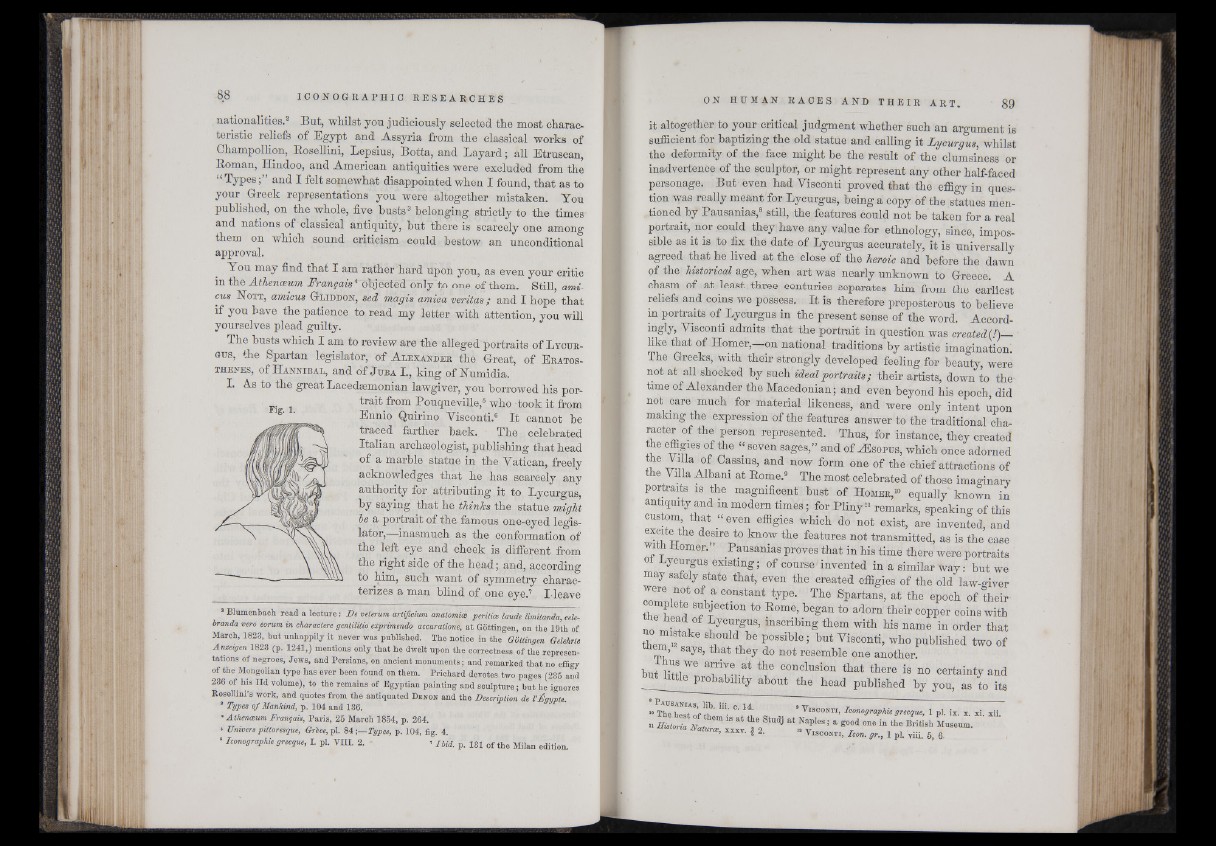
nationalities.2 But, whilst you judiciously selected the most characteristic
reliefs of Egypt and Assyria from the classical works of
Champollion, Rosellini, Eepsius, Botta, and Bayard ; all Etruscan,
Roman, Hindoo, and American antiquities were excluded from the
“ Types;” and I felt somewhat disappointed when I found, that as to
your Greek representations you were altogether mistaken. You
published, on the whole, five busts3 belonging strictly to the times
and nations of classical antiquity, but there is scarcely one among
them on which sound criticism could bestow an unconditional
approval.
You may find that I am rather hard upon you, as even your critic
in the Athenoeum Français4 objected only to one of them. Still, amicus
H ott, amicus Gliddon, sed magis arnica veritas ; and X hope that
if you have the patience to read my letter with attention, you will
yourselves plead guilty.
The busts which I am to review are the alleged portraits of B ycur-
gus, the Spartan legislator, of A l exander the Great, of E ratosth
en es , of H a nnibal, and of J uba I . , king of Humidia.
I. As to the great Bacedæmonian lawgiver, you borrowed his por-
Fi j trait from Pouqueville,5 who took it from
Ennio Quirino Visconti.6 It cannot be
traced farther back. The celebrated
Italian archæologist, publishing that head
of a marble statue in the Vatican, freely
acknowledges that he has scarcely any
authority for attributing it to Bycurgus,
by saying that he thinks the statue might
le a portrait of the famous one-eyed legislator,—
inasmuch as the conformation of
the left eye and cheek is different from
the right side of the head; and, according
to him, such want of symmetry characterizes
a man blind of one eye.7 I-leave
! Kumenbach read a lecture: De veterum artifieium anatomies periiioe laude limitanda, cele-
branda vero eorum in charactere gentilttio exprimendo accuratione, at Gottingen, on the 19th of
March, 1823, but unhappily it never was published. The notice in the Gottingen Gelehrte
Anzeigen 1823 (p. 1241,) mentions only that he dwelt upon the correctness of the representations
of negroes, Jews, and Persians, on ancient monuments ; and remarked that no effigy
of the Mongolian type has ever been found on them. Prichard devotes two pages (235 and
236 of his lid volume), to the remains of Egyptian painting and sculpture ; but he ignores
Rosellim’s work, aid quotes from the antiquated D e n o n and the Description de VÉgypte.
* Types of Mankind, p. 104 and 186.
'Athenoeum Français, Paris, 25 March 1854, p. 264.
‘ Univers pittoresque, Grice, pi. 84 ;—Types, p. 104, fig. 4.
• Iconographie grecque, I. pl. VIII. 2. - ’ Ibid. p. 131 of the Milan edition.
it altogether to your critical judgment whether such an argument is
sufficient for baptizing the old statue and calling it Lycurgus, whilst
the deformity of the face might be the result of the clumsiness or
inadvertence of the sculptor, or might represent any other half-faced
personage. But even had Visconti proved that the effigy in question
was really meant for Bycurgus, being a copy of the statues mentioned
by Pausanias,8 still, the features could not be taken for a real
portrait, nor could they have any value for ethnology, since, impossible
as it is to fix the date of Bycurgus accurately, it is universally
agreed that he lived at the close of the heroic and before the dawn
of the historical age, when art was nearly unknown to Greece. A
chasm of at least three centuries separates him from the earliest
reliefs and coins we possess. It is therefore preposterous to believe
in portraits of Bycurgus in the present sense of the word. Accordingly*
Visconti admits that the portrait in question was created (!)__
hke that of Homer,—on national traditions by artistic imagination.
The Greeks, with their strongly developed feeling for beauty, were
not at all shocked by such ideal 'portraits; their artists, down to the
time of Alexander the Macedonian; and even beyond his epoch, did
not care much for material likeness, and were only intent upon
making the expression of the features answer to the traditional character
of the person represented. Thus, for instance, they created
the effigies of the “ seven sages,” and of ^sopus, which once adorned
I?6 H H Cassms’ and now form one of the chief attractions of
the Villa Albani at Rome.9 The most celebrated of those imaginarv
portraits is the magnificent bust of Homer,10 equally known in
antiquity and in modem times; for Pliny11 remarks, speaking of this
custom that “ even effigies which do not exist, are invented, and
^cite the desire to know the features not transmitted, as is the case
wnn tlomer. ’ Pausanias proves that in his time there were portraits
ot Bycurgus existing; of course invented in a similar way: but we
may safely state that, even the created effigies of the old law-giver
were not of a constant type. The Spartans, at the epoch of their
complete subjection to Rome, began to adorn their copper coins with
“ m inscribing them with his name in order that
1 3 S P E possible; tut Visconti, who published two of
’ ys>tbat they do not resemble one another.
but Z Z 1116 conclusion tbat there is no certainty and
________ probability about the head published by you, as to its
* •^•^SANIAS, lib. iii i» 14. g tt r
10 Thebftst nf I Ü H VISCONTI, Iconographie grecque, 1 pl. ix . x. x i. x ii.
-M B È & 8 5 jatSK3! agood- , x x x v . g 2. Visconti, Icon, gr., 111 1 ptLh evBiiir.i t5i,s h6M- — ■